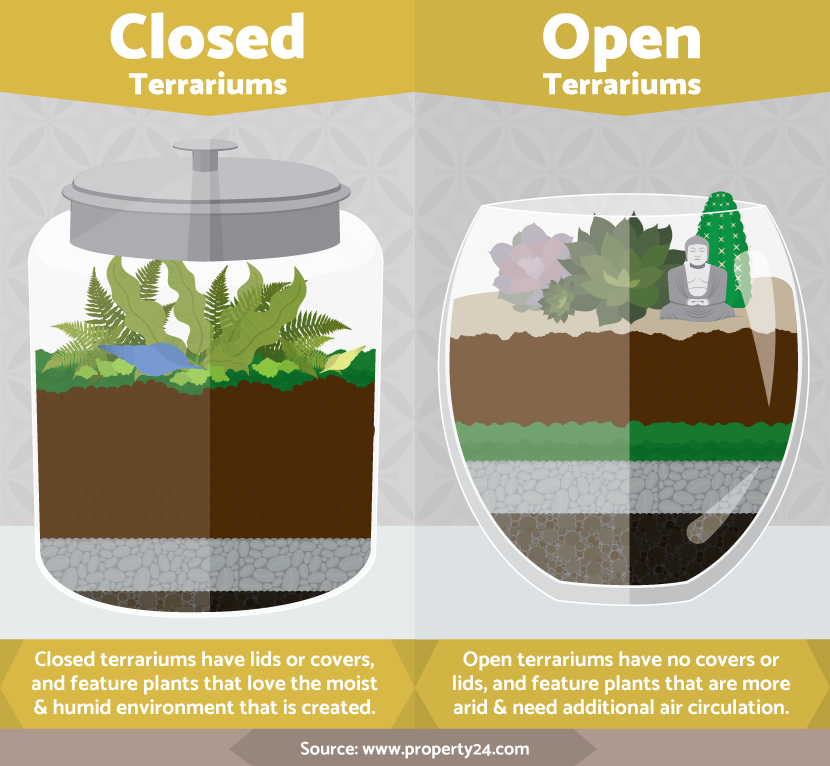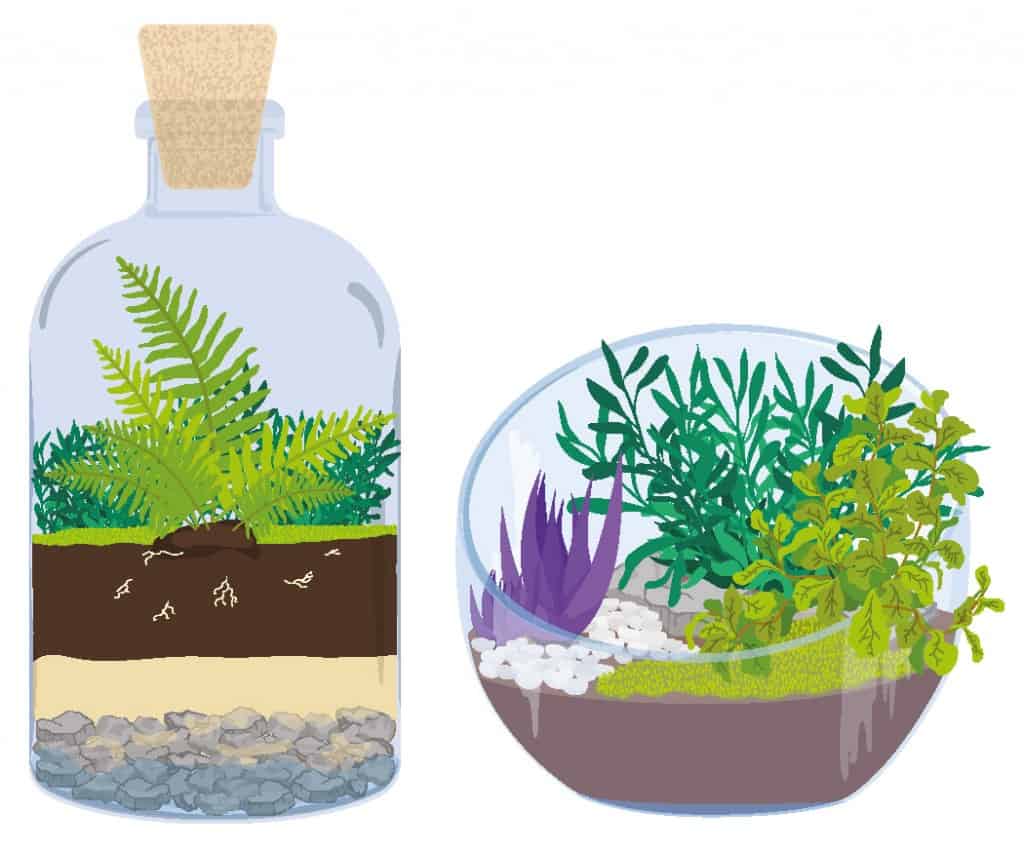Open terrariums allow air circulation and are suitable for dry plants. Closed terrariums create a humid environment, ideal for tropical plants.
Terrariums are miniature gardens housed within glass containers. Open terrariums are perfect for succulents and cacti, needing good airflow and low humidity. Closed terrariums, on the other hand, are self-sustaining ecosystems that trap moisture, making them perfect for ferns and mosses.
Each type offers unique benefits and challenges, depending on the plants you wish to grow. Understanding the differences helps you create a thriving mini-garden tailored to your plant’s needs. Whether you choose open or closed, both types bring a piece of nature indoors, enhancing your living space with greenery.

Credit: www.starnetlibraries.org
Introduction To Terrariums
Terrariums are mini indoor gardens housed in glass containers. These beautiful, self-contained ecosystems offer a unique way to bring nature indoors. They are perfect for those with limited space or who want a low-maintenance green space.
What Is A Terrarium?
A terrarium is a glass container that holds plants and soil. It can be open or closed, depending on the plants and the desired environment. Open terrariums are suitable for dry plants like succulents. Closed terrariums create a humid environment, ideal for tropical plants.
Benefits Of Terrariums
- Space-saving: Terrariums are perfect for small spaces.
- Low maintenance: They require minimal care and watering.
- Decorative: They add a touch of greenery to any room.
- Educational: They provide a learning experience about ecosystems.
| Open Terrarium | Closed Terrarium |
|---|---|
| Best for dry plants | Best for humid plants |
| Needs more watering | Requires less watering |
| More airflow | Less airflow |
Types Of Terrariums
Terrariums are miniature indoor gardens enclosed in glass containers. They can be categorized into two main types: open terrariums and closed terrariums. Each type has its unique characteristics and requirements. Below, we explore the differences between these two fascinating types of terrariums.
Open Terrariums
Open terrariums are ideal for plants that thrive in dry conditions. These terrariums do not have a lid, allowing air to circulate freely.
- Plants: Succulents, cacti, and air plants are perfect for open terrariums.
- Watering: They require less frequent watering due to lower humidity.
- Light: These terrariums need bright, indirect sunlight.
Open terrariums are easy to maintain. They are great for beginners.
Closed Terrariums
Closed terrariums create a humid environment. They have a lid or cover that traps moisture inside.
- Plants: Ferns, mosses, and tropical plants thrive in closed terrariums.
- Watering: They need minimal watering due to high humidity levels.
- Light: These terrariums prefer indirect, low to moderate light.
Closed terrariums are self-sustaining ecosystems. They are perfect for those who love low-maintenance gardens.
| Type | Ideal Plants | Watering | Light Requirements |
|---|---|---|---|
| Open Terrariums | Succulents, Cacti, Air Plants | Less Frequent | Bright, Indirect Sunlight |
| Closed Terrariums | Ferns, Mosses, Tropical Plants | Minimal | Indirect, Low to Moderate Light |
Plant Choices
Choosing the right plants is crucial for both open and closed terrariums. The plant choices depend on the terrarium’s specific environment. Let’s explore the best options for each type.
Best Plants For Open Terrariums
Open terrariums have better air circulation. They are perfect for dry and arid plants. Here are some excellent choices:
- Succulents: These plants store water in their leaves. They thrive in dry conditions.
- Cacti: Cacti need minimal water and love sunlight. They are low-maintenance.
- Air Plants: These plants absorb moisture from the air. They don’t need soil.
- Herbs: Thyme, rosemary, and sage grow well in open terrariums. They need good airflow.
Best Plants For Closed Terrariums
Closed terrariums create a humid environment. They are perfect for moisture-loving plants. Here are some top choices:
- Ferns: These plants love humidity. They thrive in low light.
- Mosses: Mosses prefer damp conditions. They add a lush, green touch.
- Peperomia: These plants have thick leaves. They retain water well.
- Fittonia: Also known as nerve plants, they prefer high humidity. Their colorful leaves add beauty.
Refer to the table below for a quick comparison:
| Plant Type | Open Terrariums | Closed Terrariums |
|---|---|---|
| Succulents | ✓ | ✗ |
| Cacti | ✓ | ✗ |
| Air Plants | ✓ | ✗ |
| Herbs | ✓ | ✗ |
| Ferns | ✗ | ✓ |
| Mosses | ✗ | ✓ |
| Peperomia | ✗ | ✓ |
| Fittonia | ✗ | ✓ |
Choosing the right plants ensures a healthy, thriving terrarium. Select plants that suit your terrarium’s environment.

Credit: www.ecoponics.com.sg
Care And Maintenance
Understanding the care and maintenance of your terrarium is crucial for its longevity. Both open and closed terrariums have unique needs. Proper care ensures your mini-ecosystem thrives.
Watering Needs
Open terrariums generally require more frequent watering. The open environment allows moisture to escape, causing the soil to dry out faster. Water your open terrarium once a week, depending on the plant type. Always check the soil’s moisture level before adding water. Overwatering can lead to root rot.
Closed terrariums maintain a humid environment. The moisture cycles within the enclosure. You might only need to water a closed terrarium once a month. Watch for condensation on the glass. If there’s too much, the terrarium might be too wet. If there’s no condensation, it may need a little water.
Light Requirements
Light is crucial for plant health in both types of terrariums.
Open terrariums thrive in bright, indirect light. Direct sunlight can scorch the plants. Place your open terrarium near a window but out of direct sunlight. Artificial lights can also be used.
Closed terrariums prefer low to medium light. Too much light can create excessive heat and humidity. This can harm the plants. Keep closed terrariums away from direct sunlight. A spot with filtered light or a few hours of indirect light daily is perfect.
| Aspect | Open Terrariums | Closed Terrariums |
|---|---|---|
| Watering Frequency | Weekly | Monthly |
| Light Needs | Bright, indirect light | Low to medium light |
Advantages Of Open Terrariums
Open terrariums offer unique benefits for plant enthusiasts. These terrariums are suitable for many types of plants. They also provide an easy-to-maintain environment. Below are some key advantages of open terrariums.
Air Circulation
Air circulation in open terrariums is excellent. Plants get a continuous supply of fresh air. This reduces the risk of mold and mildew. Open terrariums are less humid than closed ones.
Airflow helps plants grow healthier. It also prevents pests and diseases. Good air circulation keeps the terrarium environment balanced.
Ease Of Access
Ease of access is another advantage of open terrariums. You can easily water and prune your plants. You can also remove dead leaves without hassle. This makes maintenance simple and quick.
Open terrariums are perfect for beginners. They require less effort to keep plants healthy. You can enjoy the beauty of your plants without much work.
Advantages Of Closed Terrariums
Closed terrariums offer many unique benefits to plant enthusiasts. These self-sustaining ecosystems are great for those who want low-maintenance indoor gardens. Let’s explore some of the key advantages of closed terrariums.
Humidity Control
Closed terrariums excel at maintaining high humidity levels. The enclosed environment traps moisture, creating a humid microclimate. This is perfect for tropical plants that thrive in humid conditions.
The glass walls of the terrarium prevent moisture from escaping. This means the air inside remains consistently humid. This is crucial for plants like ferns and mosses, which need constant humidity.
Less Frequent Watering
One major advantage is less frequent watering. The closed system recycles water through condensation and evaporation. This natural cycle keeps the soil moist for longer periods.
In a closed terrarium, you might only need to water the plants once a month. This makes it ideal for busy people or those who travel often. You save time and effort while still maintaining a healthy garden.
Here’s a quick comparison table to highlight these advantages:
| Advantage | Description |
|---|---|
| Humidity Control | Maintains high humidity levels for tropical plants |
| Less Frequent Watering | Requires watering only once a month |
Challenges And Solutions
Terrariums are beautiful miniature gardens. They bring nature indoors. But, they come with challenges. Here, we discuss the common issues and their solutions.
Common Issues In Open Terrariums
Open terrariums lack a lid. They face unique challenges. Let’s explore these issues and their solutions.
- Low Humidity: Open terrariums lose moisture quickly.
- Pest Infestation: Bugs can enter easily.
- Watering: Plants may dry out faster.
Solutions:
- Place a shallow water dish inside. It boosts humidity.
- Use neem oil spray. It keeps pests away.
- Water plants more frequently. Check soil moisture often.
Common Issues In Closed Terrariums
Closed terrariums have a lid. They create a sealed environment. These too have their own set of issues.
- Condensation: Excess moisture may fog up the glass.
- Mold Growth: High humidity can cause mold.
- Lack of Air Circulation: Stale air can harm plants.
Solutions:
- Open the lid occasionally. This lets excess moisture escape.
- Remove moldy plants immediately. Use a clean cloth to wipe the glass.
- Allow fresh air in once a week. This helps maintain air quality.

Credit: www.46spruce.com
Choosing The Right Terrarium
Deciding between an open or closed terrarium depends on several factors. Assessing your environment and plant preferences will guide you to the best choice. Below, we explore these key considerations.
Assessing Your Environment
Your environment plays a crucial role in terrarium selection. Consider these factors:
- Humidity Levels: Closed terrariums are ideal for humid environments. Open terrariums suit dry conditions better.
- Light Availability: Open terrariums thrive in bright light. Closed terrariums prefer indirect light.
- Temperature: Stable temperatures favor closed terrariums. Open terrariums handle fluctuating temperatures well.
Considering Your Plant Preferences
The types of plants you love also influence your terrarium choice. Think about these points:
- Moisture-Loving Plants: Ferns and mosses do well in closed terrariums. They need constant humidity.
- Succulents and Cacti: These plants thrive in open terrariums. They prefer dry air and lots of light.
- Orchids and Air Plants: Open terrariums suit these plants. They need good air circulation.
Here is a quick comparison to help you decide:
| Factor | Open Terrarium | Closed Terrarium |
|---|---|---|
| Humidity | Low | High |
| Light | Bright | Indirect |
| Temperature | Fluctuating | Stable |
| Plant Types | Succulents, Cacti | Ferns, Mosses |
Conclusion
Choosing between open and closed terrariums depends on your plant preferences and maintenance level. Open terrariums suit dry-loving plants. Closed terrariums create a humid environment. Both types offer unique benefits and aesthetics. Assess your space and care routine to decide.
Happy gardening and enjoy your beautiful, thriving terrarium!
